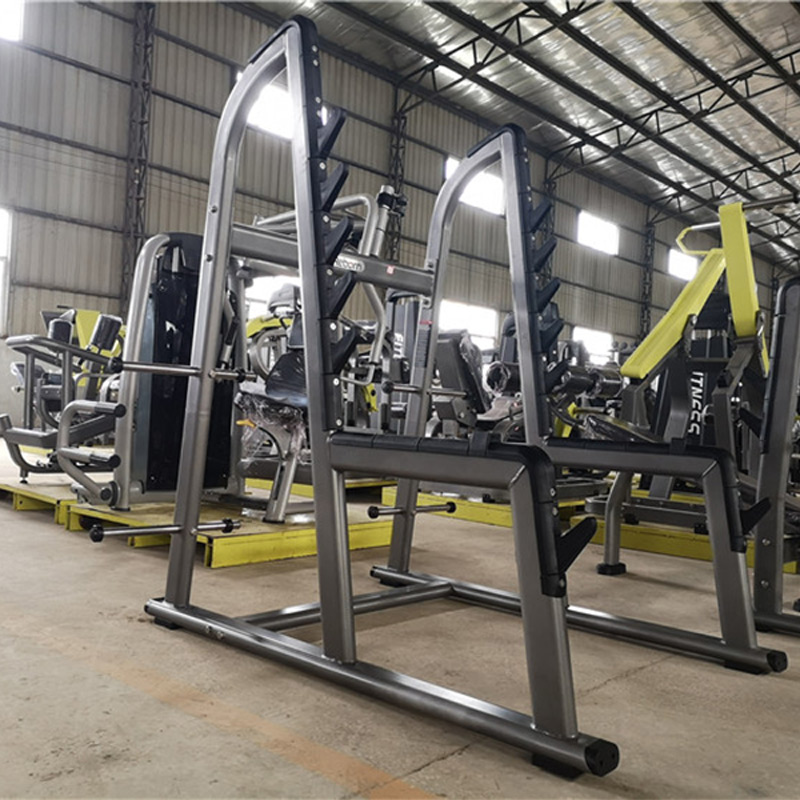A Squat Rack, also known as a Power Rack or Squat Stand, is a fundamental piece of gym equipment designed primarily for performing squat exercises and other compound lifts safely and effectively. It provides a stable and adjustable framework that supports a barbell, enabling users to lift heavy weights while minimizing the risk of injury. Here’s an introduction to its features, benefits, and typical uses:
Features of the Squat Rack
- Sturdy Frame: Constructed from heavy-duty steel or metal tubing to ensure stability and durability, capable of supporting heavy loads.
- Adjustable J-Hooks: Includes adjustable J-hooks or barbell holders that allow users to set the height of the barbell for different exercises and individual preferences.
- Safety Bars or Spotter Arms: Features safety bars or spotter arms positioned along the sides to catch the barbell if the user is unable to complete a lift, providing safety during solo workouts.
- Pull-Up Bar (Optional): Some models may include a pull-up bar at the top for performing pull-ups, chin-ups, and various grip exercises.
- Compact Design: Designed to be space-efficient, suitable for both home gyms and commercial fitness facilities with limited space.
Benefits of Using a Squat Rack
- Safety: Provides a safe environment for performing squats and other heavy lifts, thanks to the adjustable safety bars or spotter arms that prevent accidents and injuries.
- Versatility: Supports a wide range of exercises beyond squats, including bench presses, overhead presses, deadlifts, and more, catering to full-body strength training.
- Progressive Overload: Allows for progressive overload by adjusting the weight plates and bar height, enabling users to increase resistance gradually as strength improves.
- Muscle Development: Facilitates muscle development and strength gains in major muscle groups such as legs, glutes, core, and upper body through compound exercises.
- Independence: Enables users to train independently without the need for a spotter, ensuring they can safely push their limits during workouts.
Typical Uses
- Squats: The primary exercise performed in a Squat Rack, involving lowering the body into a squat position with the barbell positioned across the shoulders or upper back.
- Bench Presses: Using the adjustable J-hooks and safety bars for performing flat, incline, or decline bench presses.
- Overhead Presses: Performing standing or seated overhead presses within the rack, utilizing the safety bars for support during heavy lifts.
- Deadlifts: Setting up the barbell at the appropriate height for deadlifts, ensuring proper form and range of motion.
- Pull-Ups and Chin-Ups: Utilizing the optional pull-up bar for upper body strength exercises, including various grip variations.
Proper Usage
- Setup: Adjust the J-hooks and safety bars to the appropriate height for the desired exercise. Ensure the Squat Rack is stable and positioned on a flat surface.
- Starting Position: Position yourself inside the rack with proper alignment and grip on the barbell or pull-up bar, depending on the exercise.
- Execution: Perform the exercise with controlled movements and proper form, using the safety bars or spotter arms as needed for safety.
- Breathing: Inhale before starting the movement and exhale during the effort phase of each repetition.
- Repetitions: Complete the desired number of repetitions and sets based on your training goals and fitness level.
Tips for Effective Use
- Warm-Up: Warm up your muscles with light cardio or dynamic stretches before using the Squat Rack to prepare your body for lifting.
- Proper Form: Maintain proper posture and alignment throughout each exercise to prevent injury and maximize muscle engagement.
- Gradual Progression: Start with lighter weights to master proper form before increasing the load. Use incremental weight increases to progressively challenge your muscles.
- Safety Considerations: Always use the safety bars or spotter arms, especially when lifting heavy weights. Avoid overestimating your strength and always lift within your




















































Reviews
There are no reviews yet.